PORSCHE BOXSTER S 2013 3.G Information Manual
Manufacturer: PORSCHE, Model Year: 2013, Model line: BOXSTER S, Model: PORSCHE BOXSTER S 2013 3.GPages: 69, PDF Size: 13.64 MB
Page 21 of 69
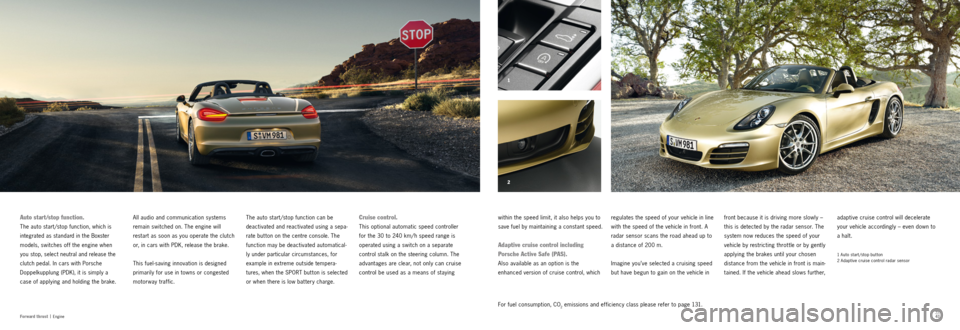
2 1
4041For fuel consumption, CO2 emissions and efficiency class please refer to page 131.
Fo r w ar d t h r u s t |
Engine
adaptive cruise control will decelerate
your vehicle accordingly – even down to
a halt.
1 Auto start /stop but ton
2 Adaptive cruise control radar sensor
front because it is driving more slowly –
this is detected by the radar sensor. The
system now reduces the speed of your
vehicle by restricting throt tle or by gently
applying the brakes until your chosen
distance from the vehicle in front is main -
tained. If the vehicle ahead slows further,
regulates the speed of your vehicle in line
with the speed of the vehicle in front. A
radar sensor scans the road ahead up to
a distance of 200 m.
Imagine you’ve selected a cruising speed
but have begun to gain on the vehicle in
within the speed limit, it also helps you to
save fuel by maintain
ing a constant speed.
Adaptive cruise control including
Porsche Active Safe (PAS).
Also available as an option is the
enhanced version of cruise control, which
Cruise control.
This optional automatic speed controller
for the 30 to 240 km/ h speed range is
operated using a switch
on a separate
control stalk on the steering
column. The
advantages are clear, not
only can cruise
control be used as a
means of staying
The auto start /stop function can be
deactivated and reactivated using a sepa-
rate but ton on the centre console. The
function may be deactivated automatical-
ly under particular circumstances, for
example in extreme outside tempera
-
tures, when the SPORT but ton is selected
or when there is low bat tery charge.
All audio and commu nication systems
remain switched on. The engine will
restart as soon as you operate the clutch
or, in cars with PDK, release the brake.
This fuel-saving innovation is designed
primarily for use in towns or congested
motorway traffic.
Auto start/stop function.
The auto start/stop function, which is
integrated as standard in the Boxster
models, switches off the engine when
you stop, select neutral and release the
clutch pedal.
In cars with Porsche
Doppelkupplung (PDK), it is simply a
case of applying and holding the brake.
Page 22 of 69

42
4342
43Fo r w ar d t h r u s t |
Engine
For fuel consumption, CO2 emissions and efficiency class please refer to page 131.
Servicing.
In the Boxster models, the generator and
air conditioning system are driven by a
single self-adjusting belt. The drive chains
on the camshafts do not normally require
servicing. With the sole exception of the
spark plugs, the ignition system is also
maintenance-free in normal servicing. In
short, longer service intervals mean long er-
lasting driving pleasure.
initiation of targeted braking. During this
process, any braking by the driver is
boosted to achieve the maximum braking
force that the system is able to provide.
Electrical system recuperation.
For enhanced ef ficiency the Boxster
models are equipped with intelligent elec -
trical system recuperation. The vehicle
bat tery is recharged by the generator
predominantly under braking. Thanks to
this selective recharging, when you
request full driving power the maximum
possible output can be directed straight to
the road.
For increased safet y, the system also
readies the brakes whenever it detects
that the distance from the vehicle is
decreasing. However, the driver should
be prepared to intervene manually if
heavier braking is required. As soon as
the road ahead clears, your vehicle will
accelerate back up to the cruising speed
originally set.
Porsche Active Safe (PAS) issues an audi -
ble and a visual warning if the system
detects that your vehicle is approaching
the vehicle in front too quickly. This is
accompanied by a brief application of
brake force and, where necessary, the
Page 23 of 69
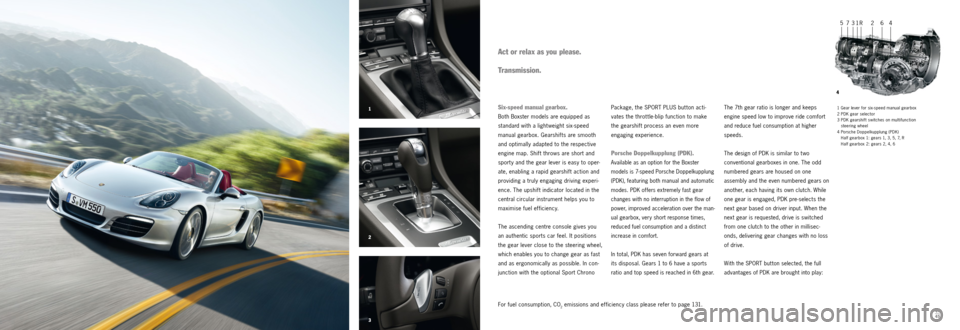
7654321R
4
3 2 1
4445
1 Gear lever for six-speed manual gearbox
2 PDK gear selector
3 PDK gearshift switches on multifunction
steering wheel
4 Porsche Doppelkupplung (PDK) H a l f ge a r b ox 1: ge a rs 1, 3, 5, 7, R
Half gearbox 2: gears 2, 4, 6The 7th gear ratio is longer and keeps
engine speed low to improve ride comfort
and
reduce fuel consumption at higher
speeds.
The design of PDK is similar to t wo
conventional gearboxes in one. The odd
numbered gears are housed on one
assembly and the even numbered gears on
another, each having its own clutch. While
one gear is engaged, PDK pre-selects the
next gear based on driver input. When the
next gear is requested, drive is switched
from one clutch to the other in millisec-
onds, delivering gear changes with no loss
of drive.
With the SPORT but ton selected, the full
advantages of PDK are brought into play:
Act or relax as you please.
Transmission.
Package, the SPORT PLUS but ton acti-
vates the throt tle-blip function to make
the gearshift process an even more
engaging experience.
Porsche Doppelkupplung (PDK).
Available as an option for the Boxster
models is 7-speed Porsche Doppelkupplung
(PDK), featuring both manual and automatic
modes. PDK offers extremely fast gear
changes with no interruption in the flow of
power, improved acceleration over the man-
ual gearbox, very short response times,
reduced fuel consumption and a distinct
increase in comfort.
In total, PDK has seven forward gears at
its disposal. Gears 1 to 6 have a sports
ratio and top speed is reached in 6th gear.
For fuel consumption, CO2 emissions and efficiency class please refer to page 131.
Six-speed manual gearbox.
Both Boxster models are equipped as
standard with a light weight six-speed
manual gearbox. Gearshifts are smooth
and optimally adapted to the respective
engine map. Shift throws are short and
sport y and the gear lever is easy to oper-
ate, enabling a rapid gearshift action and
providing a truly engaging driving experi-
ence. The upshift indicator located in the
central circular instrument helps you to
maximise fuel efficiency.
The ascending centre console gives you
an authentic sports car feel. It positions
the gear lever close to the steering wheel,
which enables you to change gear as fast
and as ergonomically as possible. In con-
junction with the optional Sport Chrono
Page 24 of 69
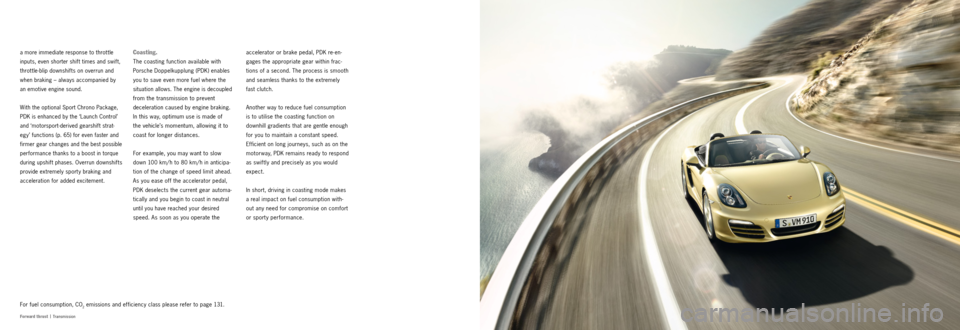
4647
Fo r w ar d t h r u s t |
Transmission
accelerator or brake pedal, PDK re-en -
gages the appropriate gear within frac -
tions of a second. The process is smooth
and seamless thanks to the extremely
fast clutch.
Another way to reduce fuel consumption
is to utilise the coasting function on
downhill gradients that are gentle enough
for you to maintain a constant speed.
Efficient on long journeys, such as on the
motorway, PDK remains ready to respond
as swiftly and precisely as you would
expect.
In short, driving in coasting mode makes
a real impact on fuel consumption with -
out any need for compromise on comfort
or sporty performance.Coasting.
The coasting function available with
Porsche Doppelkupplung (PDK) enables
you to save even more fuel where the
situation allows. The engine is decoupled
from the transmission to prevent
deceleration caused by engine braking.
In this way, optimum use is made of
the vehicle’s momentum, allowing it to
coast for longer distances.
For example, you may want to slow
down 100 km/ h to 80 km/ h in anticipa -
tion of the change of speed limit ahead.
As you ease off the accelerator pedal,
PDK deselects the current gear automa -
tically and you begin
to coast in neutral
until you have reached
your desired
speed. As soon as you
operate the
For fuel consumption, CO2 emissions and efficiency class please refer to page 131.
a more immediate response to throt tle
inputs, even shorter shift times and swift,
throttle-blip downshifts on overrun and
when braking – always accompanied by
an emotive engine sound.
With the optional Sport Chrono Package,
PDK is enhanced by the ‘Launch Control’
and ‘motorsport- derived gearshif t strat-
egy’ functions (p. 65) for even faster and
firmer gear changes and the best possible
performance thanks to a boost in torque
during upshift phases. Overrun downshifts
provide extremely sport y braking and
acceleration for added excitement.
Page 25 of 69
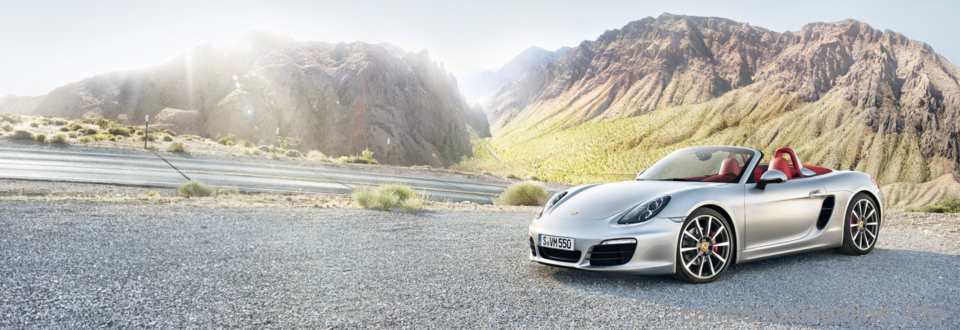
Page 26 of 69
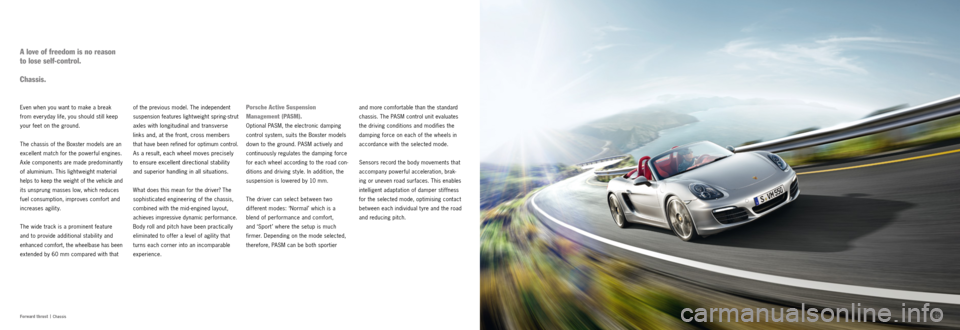
5051
Fo r w ar d t h r u s t |
Chassis
and more comfortable than the standard
chassis. The PASM control unit evaluates
the driving conditions and modifies the
damping force on each of the wheels in
accordance with the selected mode.
Sensors record the body movements that
accompany powerful acceleration, brak
-
ing or uneven road surfaces. This enables
intelligent adaptation of damper stif fness
for the selected mode, optimising contact
bet ween each individual t yre and the road
and reducing pitch.
Porsche Active Suspension
Management (PASM).
Optional PASM, the electronic damping
control system, suits the Boxster models
down to the ground. PASM
actively and
continuously regulates the damping force
for each wheel according to the
road con-
ditions and driving st yle. In addition, the
suspension is lowered by 10 mm.
The driver can select bet ween t wo
dif ferent modes: ‘Normal’ which is a
blend of performance and comfort,
and ‘Sport ’ where the setup is much
firmer. Depending on the mode selected,
therefore, PASM can be both sportier
of the previous model. The independent
suspension features lightweight spring-strut
axles with longitudinal and transverse
links and, at the front, cross members
that have been refined for optimum control.
As a result, each wheel moves precisely
to ensure excellent directional stability
and superior handling in all situations.
What does this mean for the driver? The
sophisticated engineering of the chassis,
combined with the mid-engined layout,
achieves impressive dynamic performance.
Body roll and pitch have been practically
eliminated to offer a level of agilit y that
turns each corner into an incomparable
experience.
Even when you want to make a break
from everyday life, you should still keep
your feet on the ground.
The chassis of the Boxster models are an
excellent match for the powerful engines.
Axle components are made predominantly
of aluminium. This lightweight material
helps to keep the weight of the vehicle and
its unsprung masses low, which reduces
fuel consumption, improves comfort and
increases agilit y.
The wide track is a prominent feature
and to provide additional stability and
enhanced comfort, the wheelbase has been
extended by 60 mm compared with
that
A love of freedom is no reason
to lose self-control.
Chassis.
Page 27 of 69
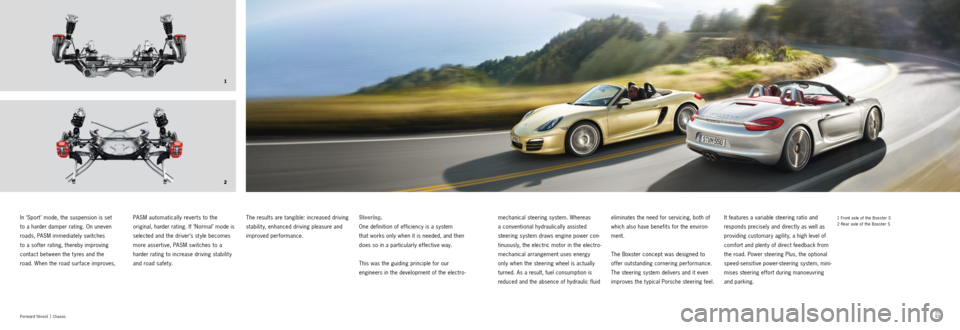
2 1
52
53
Fo r w ar d t h r u s t |
Chassis
1 Front axle of the Boxster S
2 Rear axle of the Boxster SIt features a variable steering ratio and
responds precisely and directly as well as
providing customary agility, a high level of
comfort and plent y of direct feedback from
the road. Power steering Plus, the optional
speed -sensitive power-steering system, mini -
mises steering ef fort during manoeuvring
and parking.
eliminates the need for servicing, both of
which also have benefits for the environ-
ment.
The Boxster concept was designed to
offer outstanding cornering performance.
The steering system delivers and it even
improves the typical Porsche steering feel.
mechanical steering system. Whereas
a conventional hydraulically assisted
steering system draws engine
power con-
tinuously, the electric motor
in the electro-
mechanical arrangement uses energy
only when the steering
wheel is actually
turned. As a result, fuel consumption is
reduced and the absence of hydraulic fluid
Steering.
One definition of efficiency is a system
that works only when it is needed, and then
does so in a particularly effective way.
This was the guiding principle for our
engineers in the development of the electro-
The results are tangible: increased driving
stability, enhanced driving pleasure and
improved performance. PASM automatically reverts to the
original, harder rating. If ‘Normal’ mode is
selected and the driver’s st yle becomes
more assertive, PASM switches to a
harder rating to increase driving stability
and road safet y.
In ‘Sport ’ mode, the suspension is set
to a harder damper rating. On uneven
roads, PASM immediately switches
to a softer rating, thereby improving
contact bet ween the t yres and the
road. When the road surface improves,
Page 28 of 69

2 1
5455
Fo r w ar d t h r u s t |
Chassis
1 18 - inch Boxster wheel
2 19 - inch Boxster S wheelThe system updates quickly and accurate-
ly after an engine start, t yre pressure cor -
rection or wheel change – for increased
comfort and safet y.
Tyre Pressure Monitoring (TPM).
Optional Tyre Pressure Monitoring (TPM)
sends warnings to the on-board comput -
er’s display screen in the event of low t yre
pressure. The 4.6-inch TFT screen in the
instrument cluster enables the driver to
check the pressure in all four t yres.
time the t yres have a low rolling resistance,
which, in turn, helps to reduce fuel con
-
sumption.
Wheels up to 20 inches are available as an
option.
The Boxster S has 19-inch wheels with
a dynamic dual-spoke design. The t yre
size at the front is 235/40 ZR 19 and
265/40 ZR 19 at the rear.
The larger rolling circumference improves
comfort and performance. At the same
The Boxster is equipped with 18-inch
wheels. Their minimalist five-spoke design
is sport y and elegant in equal measure.
Tyre sizes are 235/45 ZR 18 and 265/45
ZR 18 at the front and rear, respectively. Wheels.
The standard wheels on the Boxster mod-
els have been enlarged by one inch com-
pared with those of the previous models.
Made from a light weight alloy, the larger
wheels reinforce the car’s imposing pres
-
ence and further improve sport y perfor-
mance.
Page 29 of 69
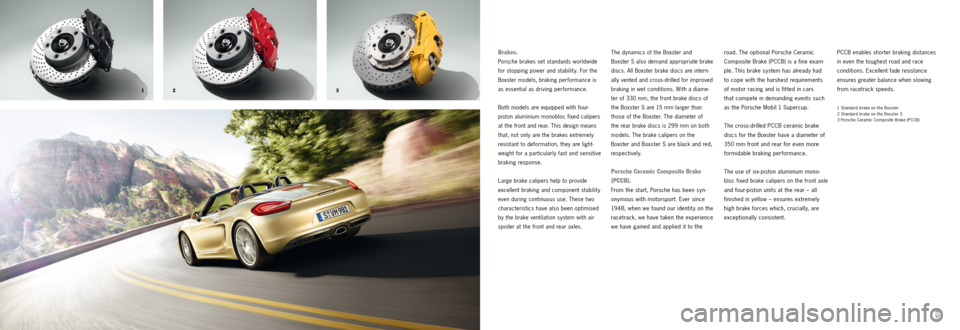
3
2
1
56
57
PCCB enables shorter braking distances
in even the toughest road and race
conditions. Excellent fade resistance
ensures greater balance when slowing
from racetrack speeds.
1 Standard brake on the Boxster
2 Standard brake on the Boxster S
3 Porsche Ceramic Composite Brake (PCCB)
road. The optional Porsche Ceramic
Composite Brake (PCCB) is a fine exam-
ple. This brake system has already had
to cope with the harshest requirements
of motor racing and is fit ted in cars
that compete in demanding events such
as the Porsche Mobil 1 Supercup.
The cross- drilled PCCB ceramic brake
discs for the Boxster have a diameter of
350 mm front and rear for even more
formidable braking performance.
The use of six-piston aluminium mono -
bloc fixed brake calipers on the front axle
and four-piston units at the rear – all
finished in yellow – ensures extremely
high brake forces which, crucially, are
exceptionally consistent.
The dynamics of the Boxster and
Boxster S also demand appropriate brake
discs. All Boxster brake discs are intern -
ally vented and cross-drilled for improved
braking in wet conditions. With a diame -
ter of 330 mm, the front brake discs of
the Boxster S are 15 mm larger than
those of the Boxster. The diameter of
the rear brake discs is 299 mm on both
models. The brake calipers on the
Boxster and Boxster S are black and red,
respectively.
Porsche Ceramic Composite Brake
(PCCB).
From the start, Porsche has been syn -
onymous with motorsport. Ever since
1948, when we found our identit y on the
racetrack, we have taken the experience
we have gained and applied it to the
Brakes.
Porsche brakes set standards worldwide
for stopping power and stability. For the
Boxster models, braking per formance is
as essential as driving performance.
Both models are equipped with four-
piston aluminium monobloc fixed calipers
at the front and rear. This design means
that, not only are the brakes extremely
resistant to deformation, they are light -
weight for a particularly fast and sensitive
braking response.
Large brake calipers help to provide
excellent braking and component stability
even during continuous use. These t wo
characteristics have also been optimised
by the brake ventilation system with air
spoiler at the front and rear axles.
Page 30 of 69
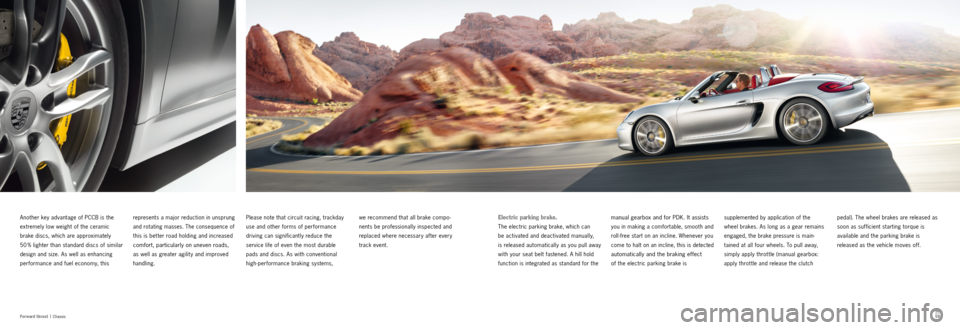
5859
Fo r w ar d t h r u s t |
Chassis
pedal). The wheel brakes are released as
soon as sufficient starting torque is
available and the parking brake is
released as the vehicle moves off.
supplemented by application of the
wheel brakes. As long as a gear remains
engaged, the brake pressure is main -
tained at all four wheels. To pull away,
simply apply throttle (manual gearbox:
apply throt tle and release the clutch manual gearbox and for PDK. It assists
you in making a comfortable, smooth and
roll-free start on an incline. Whenever you
come to halt on an incline, this is detected
automatically and the braking effect
of the electric parking brake is
Electric parking brake.
The electric parking brake, which can
be activated and deactivated manually,
is released automatically as you pull away
with your seat belt fastened. A hill hold
function is integrated as standard for the
we recommend that all brake compo
-
nents be professionally inspected and
replaced where necessary after every
track event.
Please note that circuit racing, trackday
use and other forms of performance
driving can significantly reduce the
service life of even the most durable
pads and discs. As with conventional
high-performance braking systems,
represents a major reduction in unsprung and rotating masses. The consequence of
this is bet ter road holding and increased
comfort, particularly on uneven roads,
as
well as greater agilit y and improved
handling.
Another key advantage of PCCB is the
extremely low weight of the ceramic
brake discs, which are approximately
50
% lighter than standard discs of similar
design and size. As well as enhancing
performance and fuel economy, this